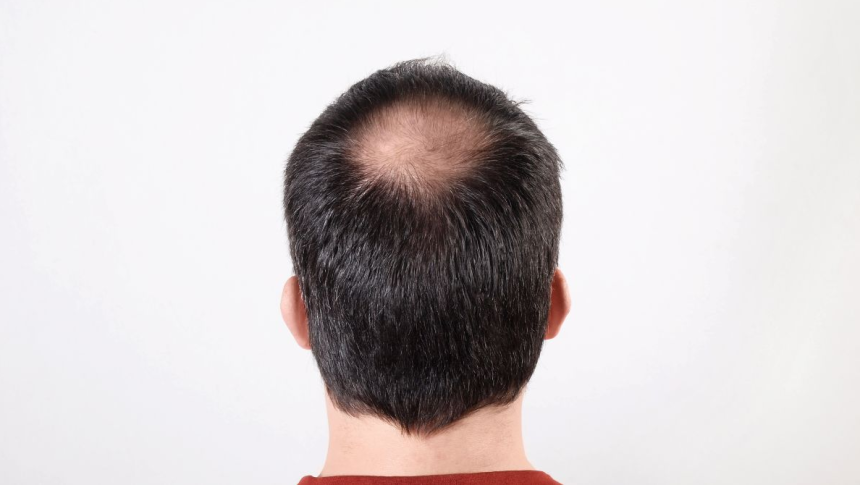Hair is the crown you never take off, and for many men, this crown symbolizes confidence and identity. Yet, for countless individuals, watching their hair thin and fall can feel like losing a part of themselves. The emotional toll of hair loss is profound, often impacting one’s self-esteem and social interactions. Hair loss is a common yet often distressing condition that affects millions of men globally. It can start as early as the late teens and becomes more prevalent with age. In men, about 50% experience some degree of hair loss by age 50, and up to 80% by age 70. The journey to combat hair loss can be a daunting one, filled with a plethora of treatments and remedies, each promising the hope of re-growth and restoration.
Causes of Hair Loss
Hair loss in males can be attributed to various factors, ranging from genetic to lifestyle influences:
- Androgenetic Alopecia: This is the most common cause of hair loss in men, also known as male-pattern baldness. It is characterized by a receding hairline and thinning on the crown, primarily driven by genetic factors and the hormone dihydrotestosterone (DHT).
- Nutritional Deficiencies: A lack of essential nutrients like iron, zinc, and vitamins (especially Vitamin D and biotin) can lead to hair thinning and loss. Poor dietary habits can exacerbate this condition.
- Stress: Physical and emotional stress can trigger hair loss conditions such as telogen effluvium, where hair follicles enter a resting phase and fall out more easily.
- Hair Treatments and Styling: The use of hair straighteners, dyes, and treatments like hair botox can damage hair shafts, leading to breakage and thinning. The heat and chemicals involved in these processes weaken the hair structure over time.
- Medical Conditions: Conditions such as thyroid disorders and lupus can contribute to hair loss. These conditions disrupt normal hormonal balances, which can impact hair growth cycles.
- Medications: Certain medications, including those used to treat cancer (chemotherapy), high blood pressure, arthritis, and depression, can have side effects that lead to hair loss.
- Scalp Infections and Skin Disorders: Fungal infections like ringworm and conditions such as psoriasis and seborrheic dermatitis can damage the scalp and hair follicles, resulting in hair loss.
- Autoimmune Diseases: Alopecia areata is an autoimmune condition where the body’s immune system attacks hair follicles, causing sudden hair loss in small patches. In severe cases, it can lead to total scalp hair loss (alopecia totalis) or complete body hair loss (alopecia universalis).
- Traction Alopecia: This type of hair loss is caused by constant pulling or tension on the hair, often due to tight hairstyles like braids, ponytails, or extensions. Over time, this can damage hair follicles and lead to permanent hair loss.
- Hormonal Changes: Hormonal fluctuations due to aging, medical conditions, or medications can affect hair growth. For example, a decrease in androgens in older men can result in hair thinning.
- Environmental Factors: Exposure to pollutants, toxins, and harsh weather conditions can weaken hair, leading to breakage and loss. Environmental stressors can impact the health of hair follicles over time.
Treatment Options for Hair Loss
Hair loss treatments can be broadly categorized into four categories: topical applications, oral supplements, injectable therapies and hair transplant.
Topical Applications
- Minoxidil: Minoxidil is a well-known over-the-counter treatment for hair loss. It is typically applied as a 2% or 5% solution or foam. Daily application is recommended, and it works by prolonging the growth phase of hair follicles. Users might experience an initial increase in hair shedding, which typically regresses within a few weeks as new hair growth becomes apparent. According to the American Academy of Dermatology (AAD), Minoxidil should be applied to the scalp twice a day for optimal results. Hair growth can usually be seen after 4-6 months of consistent use. However, some individuals, known as Minoxidil non-responders, might not see significant results due to a deficiency in the sulfo-transferase enzyme, which is necessary for converting Minoxidil into its active form. In such cases, sulfo-transferase activator lotions are now available and should be applied 10 minutes before applying Minoxidil to enhance its effectiveness.
- Aminexil: Aminexil, a derivative of Minoxidil, is used to prevent hair loss by fighting against the hardening of hair roots and collagen accumulation around them. Studies suggest that Aminexil can improve hair density and slow down the hair loss process
- Redensyl, Anagain, Capixyl, and Melatonin: These newer topical treatments are designed to stimulate hair growth through various mechanisms. Redensyl targets stem cells in hair follicles, Anagain is derived from pea sprouts and encourages hair growth, Capixyl is a peptide-based treatment, and melatonin has antioxidant properties that benefit hair health. Redensyl has shown promise in clinical studies, with some research suggesting it might be more effective than Minoxidil in promoting hair growth. A study published in the “International Journal of Trichology” found that Redensyl significantly increased hair growth and reduced hair loss compared to a placebo.
- Procapil: This is a combination of a vitaminated matrikine (biotinyl-GHK), apigenin (a flavonoid from citrus), and oleanolic acid (derived from olive trees). Procapil has been shown to improve the strength of hair and prevent hair loss by promoting blood flow to the scalp and strengthening hair follicles.
- Topical Finasteride: While Finasteride is typically taken orally, it can also be applied topically to reduce the risk of systemic side effects. Studies have shown that topical Finasteride can be effective in reducing hair loss and promoting hair growth.
- Ketoconazole Shampoo: Ketoconazole is an antifungal medication that can be used in shampoo form to treat dandruff and other scalp conditions. Some studies suggest that it can also reduce hair loss by reducing inflammation and the production of DHT on the scalp.
Oral Medications
- Multivitamins: Ensuring adequate intake of essential vitamins and minerals can support hair health. Supplements containing biotin, zinc, iron, and vitamins D and E are commonly recommended.
- Ortho-Silicic Acid: Ortho-silicic acid is a bioavailable form of silicon, a trace element important for the synthesis of collagen and keratin. Studies have shown that ortho-silicic acid can strengthen hair and improve its elasticity, promoting hair growth and reducing hair loss.
- Oral Minoxidil: Though not as widely used as the topical form, oral Minoxidil can be prescribed for severe cases of hair loss. It is effective but carries a higher risk of side effects such as cardiovascular issues.
- Oral Finasteride: This oral medication works by inhibiting the enzyme 5-alpha-reductase, which converts testosterone into DHT. Finasteride has been shown to be effective in reducing hair loss and promoting regrowth. Potential side effects include sexual dysfunction, though these are rare and often temporary, affecting less than 1% of users.
- Oral Dutasteride: Similar to Finasteride, Dutasteride inhibits both type I and type II 5-alpha-reductase enzymes. It has been found to be more potent than Finasteride in reducing DHT levels and is used in cases where Finasteride is less effective.
Injectable Therapies
- PRP Therapy (Platelet-Rich Plasma): PRP involves drawing a small amount of blood from the patient, processing it to concentrate the platelets, and injecting it into the scalp. The growth factors in PRP stimulate hair follicles, promoting regrowth and improving hair density. Studies have shown PRP to be effective, particularly when combined with other treatments.
- GFC Therapy (Growth Factor Concentrate): Similar to PRP, GFC involves concentrating growth factors from the patient’s blood. It is designed to offer a more potent stimulation of hair follicles, leading to better results.
- U-225 Mesotherapy: This involves injecting a cocktail of vitamins, minerals, and medications directly into the scalp. It aims to nourish and rejuvenate hair follicles, promoting healthier hair growth.
- Hair transplantation: It is a surgical procedure for treating hair loss by moving hair follicles from a donor site to a balding area. It is indicated for pattern baldness, hair loss due to injury, or ineffective results from other treatments. The main techniques are Follicular Unit Extraction (FUE), where individual follicles are transplanted; Follicular Unit Transplantation (FUT), involving a strip of scalp; and Direct Hair Implantation (DHI), which uses a specialized tool for direct implantation.
What is new?
- QR-678 Therapy: QR-678 is a novel, patented formulation consisting of several growth factors. It has shown promising results in clinical studies, with significant improvement in hair density and thickness.
- Exosomes: These are tiny vesicles containing proteins, lipids, and RNA that can promote cell communication and regeneration. Exosome therapy is emerging as a cutting-edge treatment for hair loss, with early studies indicating strong potential.
- Regenera stem cell therapy: It uses autologous micrografts, where stem cells and growth factors from the patient’s tissue are injected into the scalp to promote hair growth. This minimally invasive procedure reduces the risk of rejection and allergic reactions. It typically shows promising results, with many patients experiencing increased hair density and thickness within a few months. Benefits include a natural approach, minimal downtime, and potential long-term hair restoration. Success rates vary, but patient satisfaction is generally high.
Additionally and equally it is crucial to dispel prevalent myths about hair fall, as they often lead to misinformation and anxiety. Addressing these myths is essential because it empowers people with accurate knowledge, fostering informed decisions about their hair care routines and treatment options. By debunking these fallacies, we promote a healthier, more realistic understanding of hair health, ultimately contributing to better management and prevention of hair loss.
Myth 1: Cutting your hair makes it grow back thicker
Fact: Many people believe that trimming hair will make it grow back thicker because the hair feels coarser when short. However, cutting hair does not change its thickness or growth rate. The blunt tip after a haircut can give the illusion of thickness.
Myth 2: Hair loss can be reversed by rubbing onion juice on the scalp
Fact: Onion juice is believed by some to stimulate hair follicles and promote growth due to its sulfur content. While there are limited studies suggesting onion juice might help in some cases, it is not a proven or widely accepted treatment for hair loss.
Myth 3: Standing on your head will increase blood flow and prevent hair loss
Fact: This myth suggests that standing on your head or hanging upside down can increase blood flow to the scalp, thereby promoting hair growth. While increased blood flow is beneficial, there is no scientific evidence that this practice can prevent hair loss.
Myth 4: Applying eggs to your hair will prevent hair loss
Fact: Home remedies like applying eggs are believed to strengthen hair and prevent loss. While these ingredients can condition and moisturize hair, they do not prevent hair loss, which is often due to internal factors.
Myth 5: Oiling your hair prevents hair loss and promotes rapid hair growth
Fact: While oiling can moisturize and condition hair, improving its overall health and reducing breakage, it does not prevent genetic hair loss or significantly accelerate hair growth. Over-oiling can also lead to scalp issues if not washed out properly.
Hair loss in males is a complex condition with diverse underlying causes, making it critical to understand these factors when choosing the right treatment. From topical applications like Minoxidil to oral supplements and cutting-edge injectable therapies, there are numerous powerful options available. Consulting with a healthcare professional is essential to identify the most effective approach, ensuring a comprehensive and personalized treatment plan. Despite the challenges of hair loss, advancements in treatment offer real hope and effective solutions. As the saying goes, “Adversity introduces a man to himself,” and with the right strategy, those affected can overcome hair loss and reclaim their confidence.
(Author is (MBBS, MD), Dermatologist, Laser Expert & Hair transplant Surgeon and Director – DERMIS Skin & Hair Clinic Bemina, Srinagar. Feedback: [email protected])









